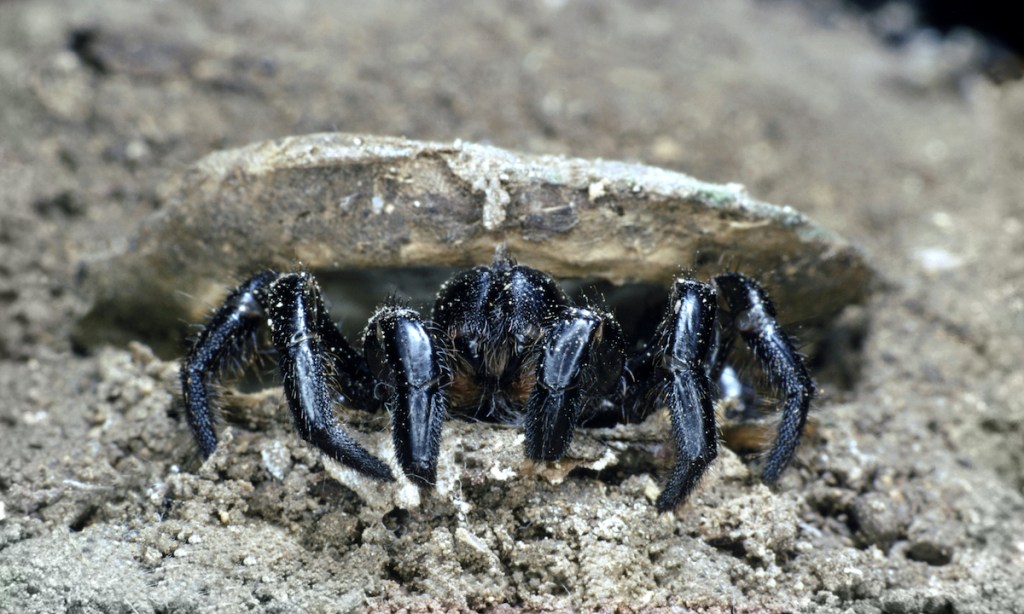

Australian scientists have just discovered a new species of arachnid, dubbed the giant trapdoor spider, in Queensland. It’s huge, bright red, and it can live for up to two decades.
Videos by Outdoors
Before you panic, we should note that trapdoor spiders aren’t considered a threat to humans. While they are venomous, their bites aren’t known to have any lasting effect on people, reports the BBC. Besides, hikers rarely encounter them; the spiders are nocturnal and spend most of their lives underground. And while they’re big for trapdoor spiders, they’re not as massive as, say, tarantulas or giant desert scorpions.
Female giant trapdoor spiders can grow up to two inches long. That’s about twice the size of other trapdoor spiders. Male trapdoor spiders are slightly smaller.
Aside from its size and stunning longevity (up to 20 years for females), the other striking thing about the giant trapdoor spider is its color. The females are a translucent red with candy cane-like stripes ringing their upper legs. The males tend to be either dark brown or iridescent maroon in hue.
The bright coloring is likely an evolutionary adaptation to ward off predators. It works, too: Even Bear Grylls says eating bugs with this kind of coloration is off limits, no matter how desperate the survival situation. In spiders, bright reds typically indicate venom. In some other species, though, unusual hues can be the result of genetic mutation. Case in point: the hot pink grasshopper discovered in Arkansas last week.
Trapdoor spiders get their name from their unique hunting strategy. They hide in a burrow underground and cover the hole with a special door made from soil bound together with spider silk. When an insect wanders by, the spider lifts the door and leaps out, snatching the hapless prey. According to reporting from The Guardian, the spider is an important component of local ecosystems and helps maintain balance among insect populations on the forest floor.
Scientists hope that the discovery of the new species will help with future conservation efforts in Australia. While there’s more work to be done to understand the spider’s true population size, researchers suspect that it’s already endangered. Further research could help scientists figure out how to protect it from further decline.











Crunch it
You’re an idiot.
Lol definitely crunch it
Oh yeah, cause I’d much rather have all kinds of nasty bugs…. It’s amazing you lived to have gray hair!!!
If they just discovered this, how did they know it lives over 20 years?
Must have just died.
They found evidence of 20 birthday partys in its little den. Apparently they can be horders.
🤣🤣🤣
😂🥂🥳🎁🎉😭😭
The people here have an IQ of a banana peel 🤣
Radiocarbon dating is the most common method by far, according to experts. This method involves measuring quantities of carbon-14, a radioactive carbon isotope — or version of an atom with a different number of neutrons. Carbon-14 is ubiquitous in the environment.
Very good . Pharaoh approved..
Radiocarbon data has nothing to do with determining the life span of organisms. 14C to 12C ratio in organic matter doesn’t stop changing until an organism dies, so you can’t use it to date the birth of a living organism. You can conceivably determine how much time has passed since a dead organism died using 14C dating, but that tells you nothing about how long it was alive. Also, the best achievable resolution for 14C dating is +/- 15 years, so there’s no way it could use it to accurately date something that happened only 20 years ago.
I was wondering the same thing.
Thoughtful question not answered in text
in the early 80.s on my way to work early one mornin. it was still dark. i saw in view of my lights, this massive spider like this crawlin off the road to my left. never forgot it. still often tell people about it. was amazeing. maybe it was one of these that i had seen but can’t remember the colour red.
There are many ways to determine the age one is to count how many times it shed it’s skin which is in the DNA
Very interesting to know that it lives for 20 years very interesting that the spider itself is red resignating element through dirt using alloy rim organic alloy rim around it’s joints the tetrahedron at the top of the shell
Nope…….just, NOPE!!
Can it be eaten on naked and afraid?
Can it be eaten on naked and afraid?
Nope . FIRE ! KIWF!
It’s fascinating to discover a new species of spider! I will often watch them weave their webs where they capture hundreds of insects each day! Less bugs to bite me! I respect them, I like them but keep a healthy distance from them so as not to annoy them!
I think it’s kind of cute. U people that say kill it are ignorant and mean. Spiders are important.
Ernie E.
Ernie E, it’s just in our names nature to love the unlovable!!! And yeah, some people would rather have roaches than spiders!!!!
If you were thinking this world couldn’t possibly get any more dangerous, I offer this newly discovered RED GIANT trapdoor spider. Just one more reason NOT to visit Australia (even though I’d really love to). That’s a hard NO for me.
Rich, you’re funny!!!! Lol
You know it’s not so much the spiders in Australia that just kills the wanting to visit such a beautiful country I’ll tell you it’s the spiders and snakes and everything else that wants to bite and kill you with just a pen drop of venom I’m good I’ll stay where it freezes and gets down to 80 below zero every winter yeah have fun on vacation
What are its pronouns?
Pingback: Scientists Discover Giant Red Spider That Can Live for 20 Years